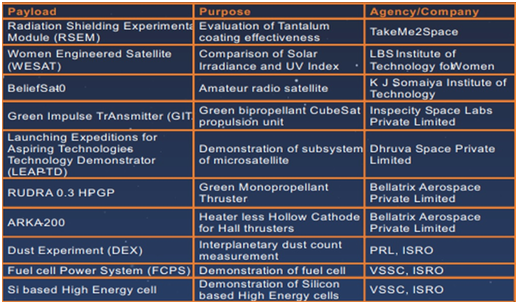Why in news?
ISRO launched a mission called PSLV-C58/XPoSat and made sure it left no debris in space. It did this by turning the last stage of the rocket into a small space station called POEM-3 (PSLV Orbital Experimental Module-3).
Instead of leaving it to float in space, they let it come back into the Earth's atmosphere after the mission was completed.
What’s in today’s article?
- POEM
- Space debris crisis
- How are space agencies dealing with debris?
POEM
- About
- It has been developed by the Vikram Sarabhai Space Centre (VSSC) as an inexpensive space platform.
- It uses the spent fourth stage of a PSLV rocket as an orbital platform.
- Used for the first time in the PSLV-C53 mission in June 2022, ISRO had POEM orbit the earth as a stabilised platform to perform in-orbit scientific experiments with various payloads.
- Features
- POEM is powered by solar panels mounted on the fuel tank of the rocket’s fourth stage and a lithium-ion (Li-ion) battery.
- It has a dedicated navigation, guidance, and control (NGC) system to stabilise its altitude along with helium control thrusters.
- It talks to ISRO’s NavIC satellite constellation for navigation and it also has a telecommand system to communicate with the ground station.
- Achievement of POEM-3
- POEM-3 featured nine payloads

- POEM-3 completed 400 orbits around the earth by its 25th day. The payloads were operationalised to perform their experiments during this time.
Space debris: A challenge
- Increasing space debris
- With the rise in the number of satellites in orbit around the earth, space debris has become a pressing issue.
- Space debris in the low earth orbit (LEO) mainly comprises pieces of spacecraft, rockets, and defunct satellites, and the fragments of objects that have deteriorated as a result of anti-satellite missile tests.
- The LEO extends from 100 km above the earth’s surface up to 2000 km above.
- It includes satellites tracking intelligence data, encrypted communication, and navigation.
- According to ISRO’s Space Situational Assessment report 2022, the world placed 2,533 objects in space in 179 launches in 2022.
- As more communication satellites/constellations are launched and more anti-satellite tests are conducted, more on-orbit breakup and collisions occur, producing smaller and smaller fragments in orbit.
- The number of space objects greater than 10 cm in size in LEO is expected to be about 60,000 by 2030, as per ISRO estimates.
- Threat to several space assets
- This debris often flies around at high speeds of up to 27,000 kilometres per hour.
- Due to their sheer volume and momentum, they pose a risk to several space assets.
- Threats on the ground: Recently, a chunk of metal believed to be a discarded battery pallet from the International Space Station ripped through the roof and two stories of a house in Florida.
- Kessler syndrome: Space debris also leads to two major risks:
- it creates unusable regions of the orbit due to excessive debris, and
- leads to the ‘Kessler syndrome’ – creation of more debris due to cascading collisions resulting from one collision.
How are space agencies dealing with debris?
- Legal provisions
- Currently, there are no international space laws pertaining to LEO debris.
- However, most space-exploring nations abide by the Space Debris Mitigation Guidelines 2002 specified by the Inter-Agency Space Debris Coordination Committee (IADC).
- This was endorsed by the U.N. in 2007.
- Space Debris Mitigation Guidelines 2002
- The guidelines outline methods to limit accidental collisions in orbit, break-ups during operations, intentional destruction, and post-mission break-ups.
- They also advise against the long-term presence of spacecraft and launch vehicle orbital stages in LEO and limit their interference in the GEO region.
- Steps taken by other countries
- NASA had instituted its Orbital Debris Program in 1979 to find ways to create less orbital debris and design equipment to track and remove existing debris.
- Currently, its Space Force tracks space debris and collisions in LEO.
- However, the agency has not implemented any technology to clean such debris yet; most such ideas are in the conceptual stage.
- European Space Agency (ESA) has adopted a ‘Zero Debris charter,’ which includes multiple ways to mitigate space debris. It has also called for zero space debris by 2030 and seeks that other agencies adopt it as well.
- Recently, China deployed a large spacecraft designed to de-orbit its defunct spacecraft.
- Japan also has a project, called the Commercial Removal of Debris Demonstration (CRD2), to tackle space junk.
- India: Apart from the POEM missions, ISRO has set up a Space Situational Awareness Control Centre to protect its high-value assets from close approaches and collisions.
- An Indian start-up named Manastu Space is working on technologies like in-space refuelling, de-orbiting of old satellites, and satellite life extension.










